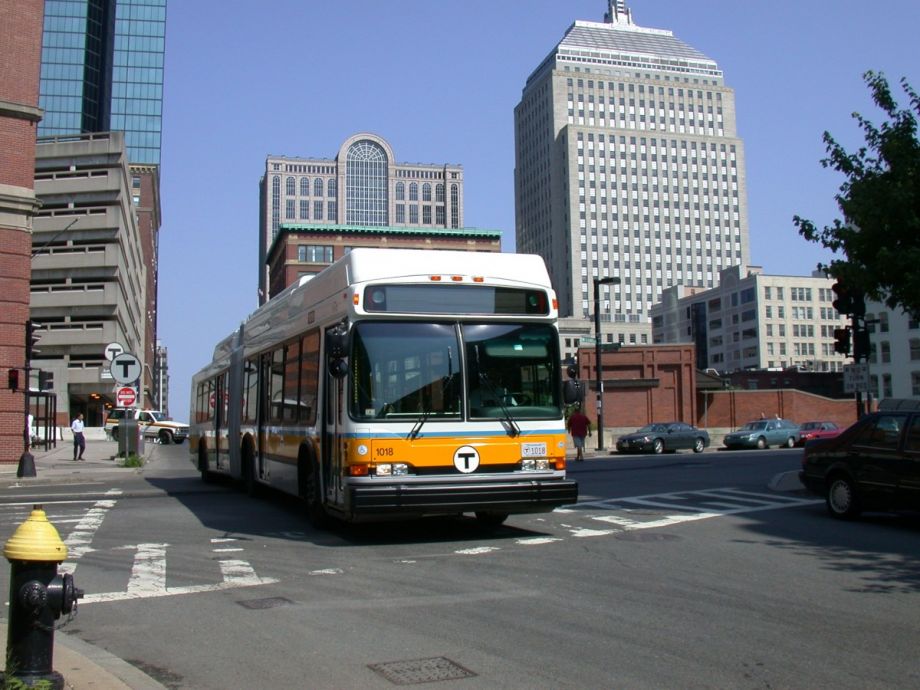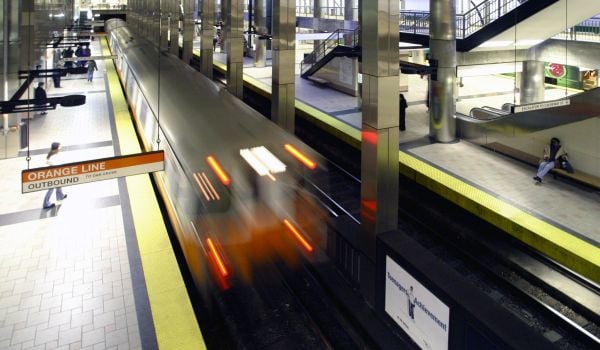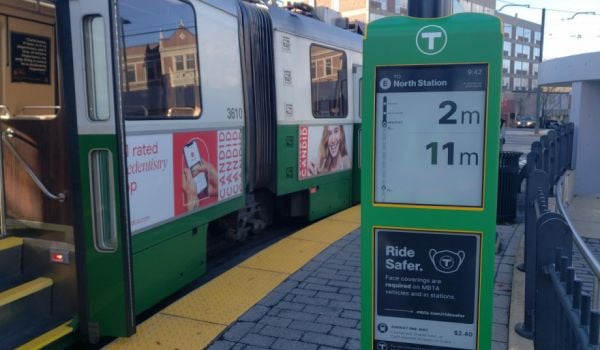Welcome to “The Mobile City,” our weekly roundup of newsworthy transportation developments.
Commentary: Free Transit Would Make Bus Drivers’ Lives Better, Too
The Massachusetts Bay Transportation Authority (MBTA) has launched a pilot project that has eliminated fares on Boston’s busiest bus route, Route 28, which connects Ruggles subway station in Roxbury with Mattapan via Nubian (formerly Dudley) Square and Blue Hiil Avenue through Dorchester. Writing in The Boston Globe, columnist Abdallah Fayyad urges city and MBTA officials to study not only the effect of free fares on ridership but also their effect on the bus drivers.
In his essay, Fayyad notes that bus drivers are the frontline workers responsible for collecting fares and enforcing fare policy. This, he argues, puts drivers in a difficult position to begin with: “If drivers were to confront every fare evader, the buses would never be on time,” he writes. “And if they don’t try to stop people from hopping on without paying, then other riders might begin to feel like there’s no point in paying.”
Bus drivers face both verbal and physical abuse from riders when they do discourage fare evasion. And that physical abuse can even turn deadly: Fayyad notes a 2008 incident where a New York City bus driver was fatally stabbed over an unpaid fare.
But even if violence never occurrs, the competing pressures of time and policy enforcement lead to arbitrary and capricious application of policy. Fayyad used a trip he took as an example: The driver waved him and a passenger he was talking to on board without paying in order to board a crowd waiting for the bus, then, a few stops later, the trip was delayed for several minutes while the driver insisted that another passenger pay the fare.
That passenger, by the way, was Black, while Fayyad isn’t. And Fayyad goes on to point out that punishment for fare evasion falls disproportionately on the shoulders of Black and brown passengers: “In Brooklyn, N.Y., for example, 90 percent of people arrested for fare evasion were Black or Hispanic. In Washington, D.C., 91 percent of citations or summons for fare evasion were issued to Black riders. And in Boston, 62 percent of people handed citations by the MBTA Transit Police were either Black or Hispanic,” he writes.
“Oftentimes, people evade fares simply because they can’t afford to pay them,” he concludes. “That’s why free public transit would create more equitable cities and increase people’s mobility. And beyond the benefits to residents and commuters, a fare-free transit system would undoubtedly improve working conditions for bus drivers — and that’s something cities should be willing to pay for.”
Transit Advocates Urge New New York Governor to Scrap a Cuomo-Era Rail Project
“Have the pigs started flying yet?” U.S. Rep. Alexandria Ocasio-Cortez (D-N.Y.) tweeted on Jan. 15 of last year. “The Daily News, the NY Post and I are actually in agreement about the same subject (AirTrain) on the same day! Someone play the numbers.” On that day, both papers ran editorials agreeing with AOC that a proposed monorail connecting LaGuardia Airport with the No. 7 subway line in Queens was a useless white elephant.
Whoever played the numbers that day might want to play them again now, for the New York Post reports that transit advocates are now pushing Gov. Kathy Hochul to scrap that project, which her predecessor Andrew Cuomo backed.
The proposed 1.5-mile “Airtrain” monorail, which has a price tag of $2.1 billion, would run on an elevated viaduct paralleling the Grand Central Parkway from the airport to the Willets Point stations on both the 7 and the Long Island Rail Road Port Washington Branch. Critics point out that the alignment requires Manhattan-bound passengers to head further east into Queens before reversing direction at Willets Point to head into Manhattan.
One transit advocate, Riders Alliance spokesperson Danny Pearlstein, told the Post that the group he represented had an alternative on the table that could do the same job as the Airtrain for far less money: “We have a proposal going back to 2015 for a free Q70 bus line, which would get people to the airport in a really short amount of time and at little expense to the MTA and no expense to riders.”
The Port Authority of New York and New Jersey defended the train in a statement that said, “The Federal Aviation Administration, based on a thorough independent review, fully approved the AirTrain, which will create the first rail mass transit link to LaGuardia Airport. Opposition to rail mass transit that will get millions of cars off the street and reduce greenhouse gases without touching a single piece of private property at this time of climate change crisis is simply indefensible.” The article notes, however, that the FAA’s own review of the project concluded that it would actually be slower than driving from Manhattan to the airport.
One other reason the project might survive: The Port Authority’s executive director, Rick Cotton, is a Cuomo appointee, as are most of the members of its board of directors. The article quotes a source familiar with discussions about the Airtrain’s future as saying that “Cotton will push this project until his last breath.”
Hochul has not taken a position for or against the project. Her spokeswoman Hazel Crampton-Hayes told the Post, “Governor Hochul is committed to a world-class airport and transportation network, and she is working with the Port Authority, community members, elected officials, and advocates to ensure transparency and robust engagement.”
Golf Carts: The Future of Urban Mobility?
As of now, the fastest-growing metropolitan area in the country is The Villages, the master-planned 55-plus community in Florida designed with the help of Imagineers from the Walt Disney Company in nearby Orlando. And an article in New York magazine’s Curbed argues that, whatever its strengths and weaknesses may be, The Villages is actually pointing the way towards the future of individual urban mobility.
And the vehicle it’s using to get there is the golf cart.
Golf carts — or “golf cars,” as Villages residents call them — provide basic mobility in The Villages’ neighborhoods. According to the article, some 60,000 golf carts, which residents can either lease or buy at prices starting at $12,000, provide one-third of all trips taken in The Villages.
Curbed’s article points out the many advantages golf carts offer: “They are lightweight and barely pollute. They’re not supposed to go faster than 20 mph, and they don’t kill many people the way cars do (although it does happen). The embrace of slow-moving, smaller vehicles is a major part of fostering a gentler, more pedestrian-friendly physical place, one with mobility options for older Americans who are more at risk of dying in car crashes wherever they are. The wholehearted embrace of them by the Villages, on the surface, seem like a prototype for elder America, at least in places where the climate is mild.”
But, the article continues, the embrace goes only so far: Villagers use golf carts as a supplement rather than a total replacement for their cars. For travel beyond their own neighborhood, Villages residents turn to the cars and SUVs they had before they moved there. Ryan Erisman, author of “Inside the Bubble: A Complete Guide to Florida’s Most Popular Community,” told Curbed, “Most people still have cars. They might come with two cars and switch to one car and one golf cart.”
The reason cars remain necessary: The Villages lack public transportation, and the community of about 130,000 people spreads across 32 square miles, an area larger than Manhattan. And it was only this year that the first multi-family residential building opened in The Villages, a development that caused fretting among residents already annoyed over growing waits for tee times at the community’s 50 golf courses.
The article points out several other problems with The Villages, some of them arising from its deliberate appeal to Baby Boomer nostalgia and others relating to its serious lack of diversity. But, it notes, the country is facing the need to accommodate a “silver tsunami” of aging Boomers who will want to be able to age in place while enjoying the same freedom of movement they had when they were younger. At least in mild climates, and maybe even seasonally in not-so-mild ones, golf carts could provide that freedom.
Know of a development that should be featured in this column? Send a Tweet with links to @MarketStEl using the hashtag #mobilecity.

Next City contributor Sandy Smith is the home and real estate editor at Philadelphia magazine. Over the years, his work has appeared in Hidden City Philadelphia, the Philadelphia Inquirer and other local and regional publications. His interest in cities stretches back to his youth in Kansas City, and his career in journalism and media relations extends back that far as well.
Follow Sandy .(JavaScript must be enabled to view this email address)
















